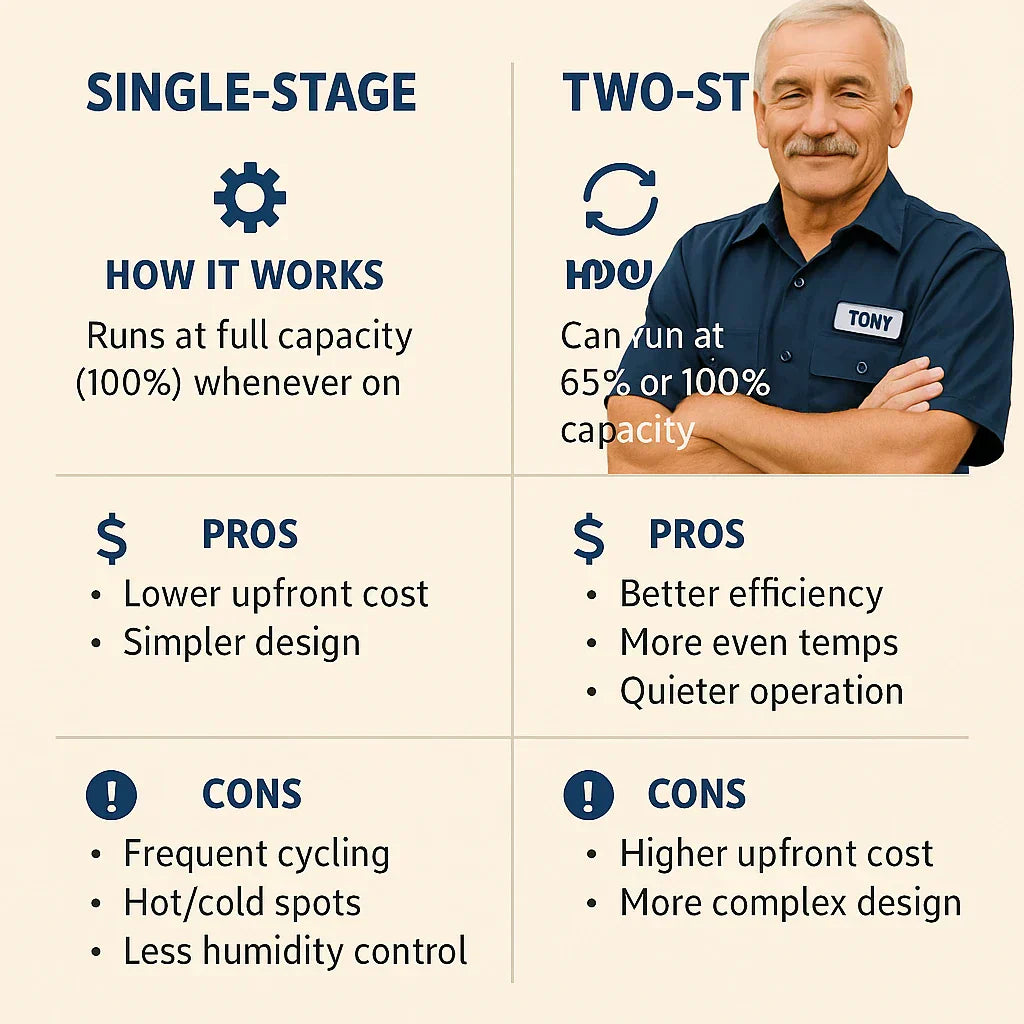When you’re investing in a 7.5 Ton packaged AC and gas furnace unit for your business, you’ll hear a lot about single-stage vs. two-stage systems. At first, it sounds like HVAC sales jargon — but the choice can have a big impact on your comfort, energy bills, and long-term ROI.
So, which one is right for you? Let’s break it down Tony-style: simple, practical, and with real-world examples.
⚙️ What Is a Single-Stage System?
A single-stage packaged system has a compressor that runs at full blast (100%) every time it turns on.
-
On or off. No in-between.
-
Cheaper to buy upfront.
-
Easier to repair and maintain.
-
But: It short cycles in mild weather (lots of on-off action), which means:
-
Wasted energy
-
Uneven temperatures
-
Less humidity control
-
👉 Tony’s analogy: A single-stage system is like driving a car that can only go 70 mph or 0 mph. Great for the highway, not so smooth in stop-and-go traffic.
🔄 What Is a Two-Stage System?
A two-stage packaged system has a compressor that can run at:
-
Low stage (~65% capacity) → handles mild days and partial loads.
-
High stage (100% capacity) → kicks in for hot summer afternoons or heavy occupancy.
That means:
-
Longer, steadier run times.
-
Better humidity control.
-
Quieter operation.
-
More consistent temperatures across large spaces.
📌 According to Carrier Commercial HVAC, part-load efficiency is where businesses save the most money, since HVAC systems rarely run at 100% all day.
👉 Tony’s analogy: A two-stage system is like having both cruise control and full throttle in your car. Smooth most of the time, power when you need it.
💲 Upfront Cost Comparison
Let’s talk dollars.
-
Single-stage 7.5 ton unit: $10,000–$13,000 (equipment only).
-
Two-stage 7.5 ton unit: $12,000–$15,000 (equipment only).
👉 Difference: About $1,500–$3,000 more for a two-stage system.
Installation costs (labor, crane, permits) are basically the same. The price gap is in the equipment itself.
📌 HVAC cost guide confirms two-stage units carry higher upfront prices but can reduce long-term operating costs.
🌡️ Comfort Differences in Real Spaces
Here’s where the rubber meets the road: How does each system feel in your building?
🛍️ Retail Store (5,000 sq. ft.)
-
Single-stage: Customers near the door get blasted with cold air, while the back stays warm. System short-cycles in spring/fall.
-
Two-stage: Runs steady at low stage, keeping temps even across the store.
🍽️ Restaurant (3,800 sq. ft. with open kitchen)
-
Single-stage: Dining room fluctuates between hot and cold as the system cycles. Kitchen heat overwhelms system at peak times.
-
Two-stage: Stays ahead of kitchen loads by running long, steady cycles. Diners barely notice the system.
🏥 Medical Office (4,200 sq. ft.)
-
Single-stage: Exam rooms get stuffy between cycles. Patients complain.
-
Two-stage: Quiet, consistent comfort — ideal for sensitive spaces.
👉 Tony’s verdict: If comfort matters to your customers or patients, two-stage is worth the extra spend.
⚡ Energy Efficiency Impact
Efficiency ratings are another key difference.
-
Single-stage units: Typically meet minimum DOE standards (around 13.0 IEER2 for 2025).
-
Two-stage units: Often achieve higher IEER2 ratings (14.0–15.0+), especially at part-load.
📌 DOE Appliance Standards confirm that efficiency minimums have risen, making two-stage units more attractive for long-term compliance.
👉 Example:
-
Old 10 IEER unit: $8,000/year cooling costs.
-
Single-stage 13 IEER2: $7,000/year.
-
Two-stage 14.8 IEER2: $5,600/year.
Savings: $1,400/year → $14,000 over 10 years.
📌 Trane highlights that part-load efficiency is where businesses save the most.
🛠️ Maintenance Considerations
-
Single-stage:
-
Fewer components.
-
Simpler repairs.
-
Slightly lower maintenance costs.
-
-
Two-stage:
-
More complex compressor.
-
Parts may cost more if they fail.
-
But: Modern systems are reliable, and warranties often cover key parts.
-
📌 ASHRAE notes that preventative maintenance is critical for both types — neglect cancels out efficiency gains either way.
📊 Real-World ROI Examples
Example 1: Office Building (5,000 sq. ft., 10-hour days, 6 days/week)
-
Single-stage annual cooling cost: $7,200
-
Two-stage annual cooling cost: $5,800
-
Difference: $1,400 per year
-
Payback: ~2 years on higher upfront cost
Example 2: Restaurant (3,500 sq. ft., high internal load)
-
Single-stage: Constant cycling, hot/cold complaints → customers unhappy.
-
Two-stage: Comfort improves = better dining experience → indirect revenue boost.
Example 3: Retail Store (4,500 sq. ft.)
-
Single-stage: Cheaper upfront, fine if open only 6 hours/day.
-
Two-stage: Better long-run savings if operating 12+ hours/day.
✅ Tony’s Take: Which Should You Choose?
Here’s my no-nonsense breakdown:
-
Pick single-stage if…
-
You’re on a tight budget.
-
Your building is under 4,000 sq. ft..
-
Occupancy and heat loads are pretty stable.
-
-
Pick two-stage if…
-
You run long hours (10+ per day).
-
Your building has variable occupancy (restaurants, retail).
-
Comfort is critical (medical, customer-facing spaces).
-
You want lower utility bills over the next decade.
-
📌 Final Word from Tony
When it comes to single-stage vs. two-stage packaged systems, it’s not about fancy HVAC jargon — it’s about how your business actually runs.
-
If you just need the cheapest install today, single-stage will work.
-
But if you want better comfort, quieter operation, and lower bills, a two-stage system is the smarter long-term play.
My advice? Run the numbers. Look at your operating hours, utility rates, and how important comfort is to your customers and staff. More often than not, a two-stage system pays for itself.
In the next topic we will know more about: Noise Levels Explained: How Quiet Is the Daikin 7.5 Ton Packaged Unit?







